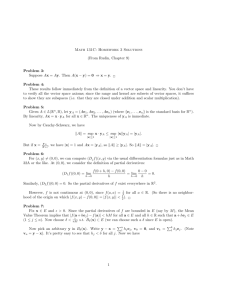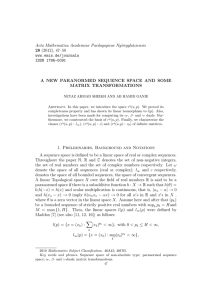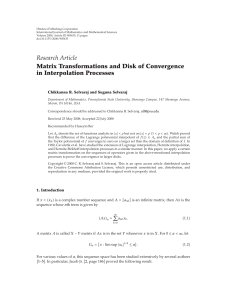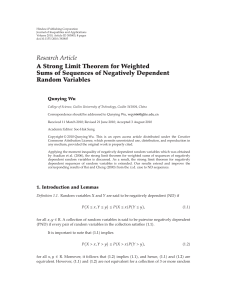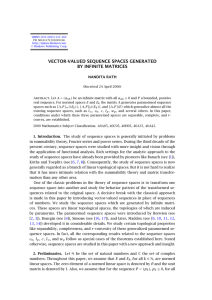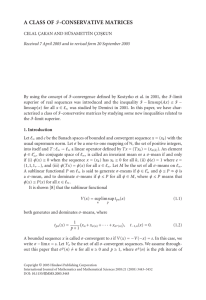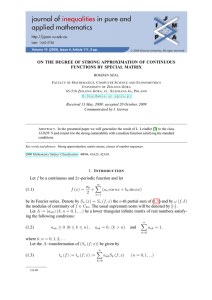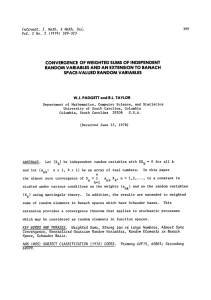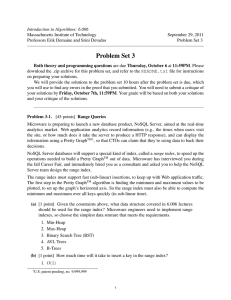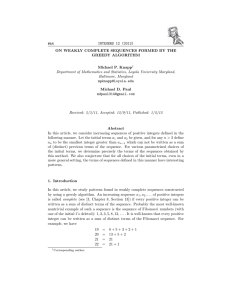Document 10437644
advertisement
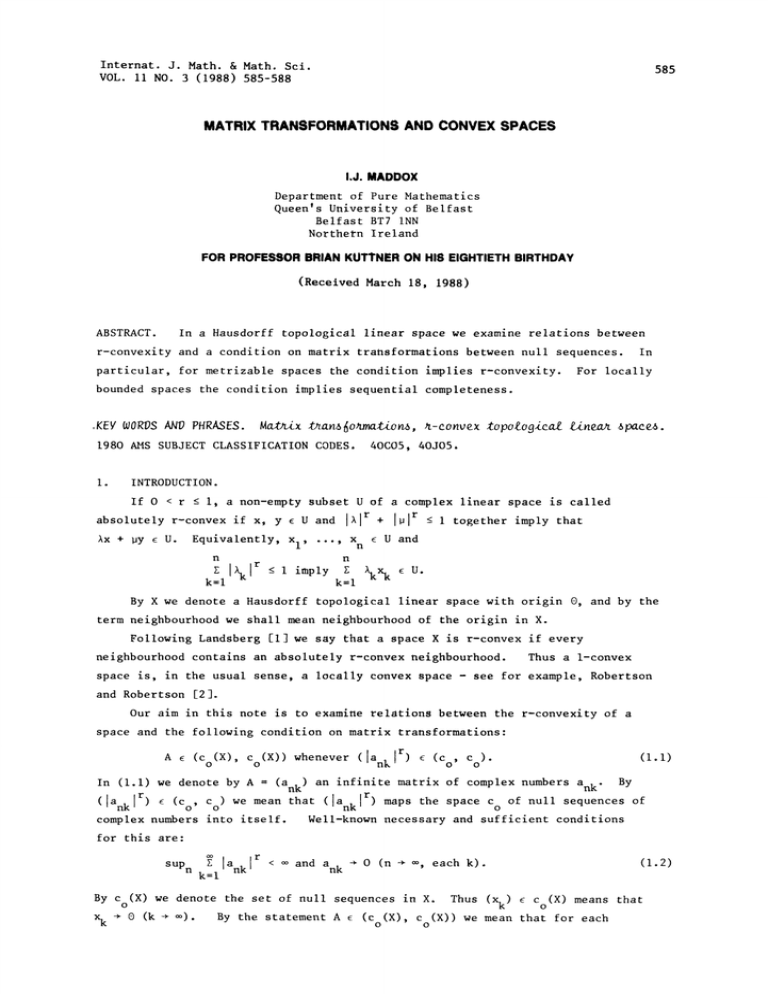
Internat. J. Math. & Math. Sci.
VOL. ii NO. 3 (1988) 585- 588
585
MATRIX TRANSFORMATIONS AND CONVEX SPACES
I.J. MADDOX
Department of Pure Mathematics
Queen’s University of Belfast
Belfast BT7 INN
Northern Ireland
FOR PROFESSOR BRIAN KUTTNER ON HI8 EIGHTIETH BIRTHDAY
(Received March 18, 1988)
In a Hausdorff topological linear space we examine relations between
ABSTRACT.
r-convexity and a condition on matrix transformations between null sequences.
particular, for metrizable spaces the condition implies r-convexity.
In
For locally
bounded spaces the condition implies sequential completeness.
,KEY WORDS
AND PHRASES.
Mati taformations, r-convex topological inear spaces.
4OCO5, 4OJO5,
1980 AMS SUBJECT CLASSIFICATION CODES.
INTRODUCTION.
1.
r -< i, a non-empty subset U of a complex linear space is called
r +
r
absolutely r-convex if x, y e U and
together imply that
If O
x
+ y e U.
Equivalently,
n
Z
k=l
term
ku-I
r
I%1
Xn
Xl,
n
<
Z
I imply
k=l
lul
U and
e
x
k
U.
By X we denote a Hausdorff topological linear space with origin 0, and by the
neighbourhood we shall mean neighbourhood of the origin in X.
Following Landsberg [I] we say that a space X is r-convex if every
neighbourhood contains an absolutely r-convex neighbourhood.
space is, in the usual sense, a locally convex space
Thus a 1-convex
see for example, Robertson
and Robertson [2].
Our aim in this note is to examine relations between the r-convexity of a
space and the following condition on matrix transformations:
(1.1)
(Co(X), Co(X)) whenever (lankl r) e (Co, Co )"
In (i.i) we denote by A
(ank) an infinite matrix of complex numbers ank. By
that (lank Ir) maps the space
we
mean
(c
(lank Ir)
o, Co
Co of null sequences of
A e
complex numbers into itself.
Well-known necessary and sufficient conditions
for this are:
sup n
By
x
k
Co(X)
0 (k
Z_ lank
k i
r
and
ank
O (n
,
we denote the set of null sequences in X.
=o).
By the statement A
(1.2)
each k).
Thus (xk) e
Co(X)
means that
(c (X), c (X)) we mean that for each
o
o
586
x
I.J. MADDOX
c
o
(X) and each natural number n we have
An(X)
Z
k=l
ankXk
convergent in X, amd also A (x)
0 (n
n
2.
).
THE NAIN RESULTS.
THEOREM i.
If X is r-convex and sequentially complete then (I.i) holds
Since X is r-convex its topology is determined by the collection
PROOF.
of aiI continuous r-seminorms on Xo
an r-seminorm if it
satisfies the conditions:
p(x+y)
.
p(x) + p(y) and p(%x)
_<
X and all complex numbers
for all x, y
[[rp(x)
Take any continuous r-seminorm p on X and let (x
=, and for natural numbers a,b
as k
b
p( Z
k =a
Hence, if
(lank jr)
{p}
RecalI that a reaI-vaIued function p on X is
b
k =a
(Co, Co)
k)
Then p(x
O
(2.1)
then (1.2) holds, and so
series in X, whence convergent.
Co(X).
e
[ank[rp(xk ).
Z
ankxk
k)
with a < b we have
kE=l ankxk
is a Cauchy
and letting b
Taking a
in (2.1) a further
A (x)
0 (n-> =). This completes the proof of
application of (1.2) shows that
n
Theorem I.
In Theorem
we may observe that neither r-convexity alone, nor sequential
completeness alone, implies (I.I).
For example, consider the r-convex space of all
finite sequences, regarded as a subspace of
e
denotes the k-th unit vector.
k
2 -k and
O for n >
alk
Then x
k
Then
r.
@ (k
Let us define x
k
k
).
Now define A
(lankl r)
ank
k=l
r"
-lek
where
(ank)
by
(c o, c ), but
o
alkXk
sequence.
Next, consider the sequentially complete space
does not converge to any finite
k
-lek
r/(r+l).
Define
and let
n
ank
-I/r
(lank Ir)
(c
o
c
o
and
n
Z
for 1 -< k < n,
fork >n.
=0
Then
where s
@ in
Xk
s
but the
s
norm of
ankXk
k=l
is equal to
n
-s / r
n
_-s
E k
k=l
which does not tend to O as n
=.
For metrizable spaces the next result is a partial converse to Theorem i.
MATRIX TRANSFORMATIONS AND CONVEX SPACES
587
If X is metrizable and (I,I) holds then X is r-convex
THEOREM 2.
Since X is metrizable we may determine a countable base
PROOF.
of balanced neighbourhoods such that
Un+ I 2-1Un
{UI,
{U1,
since
2
O (j
Pi(Xj)
is a base, it follows that if
U
) for each i, then
Let us suppose, if
PU
by
x e V}
inf{l > O
Also, for each natural number i we shall write
for each x e X.
2
I, 2,
for n
Now for any balanced neighbourhood U we define the Minkowski gauge
Pu(X)
U
Then,
i
is a sequence such that
).
O (j
x.j
(xj)
PU."
Pi
possible, that X is not r-convex.
Then there exists
a neighbourhood V such that for each natural number n the absolutely r-convex hull
is not contained in V.
Hence, for each n, there exist x(n,l), x(n,2)
n
x(n,m(n)) in Un and there exist complex numbers (n,l), (n,2),..., (n,m(n))) with
of U
m(n)
E
k--1
r
I),(n,k)
<
(2.2)
such that
m(n)
E k(n,k) x(n,k)
#
V.
(2.3)
k=l
(ank)
Now define an infinite matrix A
alk
a2k
a3k
as follows:
%(l,k) for I -< k < m(1) and alk 0 otherwise;
%(2,k) for m(1) < k < m(2) and a2k 0 otherwise;
k _< m(3) and
%(3,k) for m(2)
a3k 0 otherwise
Then it follows from (2 2) that
(lank [r
e
(Co, Co)
whence Ae
(Co(X) Co(X))
by (i.I).
Next, we define a
x
sequence,
(xj)
x
by
x(l,m(1)), x(2,1)
(x(l,l), x(l,2)
x(2,m(2))
).
Thus, it is clear that
A (x)
n
re(n)
E (n,k)x(n,k).
k=l
Let us choose any natural number i.
Since
Un+ I
2-1Un
for n
1,2,... it follows
that
Pi(x(n’k))
-< 2 i-n
for each n > i and for I < k < re(n).
whence x.
A (x)
n
@ (j
@ (n- )
(24)
But (2.4) implies that
0 (j
),
), and since A e (c (X) Co(X)) it follows that
o
which is contrary to (2 3). Hence X must be r-convex which
Pi(Xj)
completes the proof.
In our final theorem below we shall show that, for the special class of
metrizable spaces known as locally bounded spaces, condition (i.i) implies
sequential completeness of the space.
We recall that a Hausdorff topological
linear space X is called locally bounded if X contains a bounded neighbourhood B,
588
I.J. KADDOX
that is a neighbourhood B such that for every neighbourhood V there exists % > O
with B
%V.
Let X be locally bounded and suppose that (I.i) holds.
THEOREM 3.
Then
X is sequentially complete.
PROOF.
Since local boundedness implies metrizability, it follows from
Theorem 2 above that X is r-convex, whence, being locally bounded and r-convex,
X must be r-normable (see for example Kthe [3], page 160).
Let
be a
II-II
suitable r-norm and suppose that
k=l
IlYkll
is any sequence in X such that
(yk)
<
By the general convergence principle for series we may construct a positive real
(k
sequence (qk) with qk
) such that
qkllyk[l
k=l
(2.5)
<
Now define a sequence (xk) by
Yk
i
Xk
qk
llyklll/r
Then
lXkl
and x
O otherwise.
k
Also, we have
_<
-r/2
qk
>
O,
for all k _>
I, whence xk
@ (k
).
lykll/r
Xk /qk
Yk
llykl
if
and by (2.5) we see that
k=l
(qk)rl lykl
.
<
Let us define a matrix A
’/qk
alk
Then (2.6) implies that
k
(2.6)
(ank)
lykll I/r
by
ank
jr).. (Co, Co)
(lank
O for n > 2
and so (I.I) implies that
ZlalkXk kZlYk
c onve r ge s.
To summarize
whenever
(yk)
is such that
[[yl]l
+
l]y2[l
+
<
it
It is readily seen that this implies the
converges.
follows that Yl + Y2 +
sequential completeness of X, which proves the theorem.
REFERENCES
I.
2.
3.
LANDSBERG, M. Lineare topologische Rume, die nicht lokalkonvex sind.
Math. Z. 65 (1956) 104-112.
ROBERTSON, A.P. and ROBERTSON, W.J. Toplqgical Vector Spaces, Cambridge
University Press, 1973.
KTHE,
G.
ToP0)0gical Vector Spaces I, Springer-Verlag, 1969.

![The Cauchy-Goursat Theorem Z ] with three points](http://s2.studylib.net/store/data/010431300_1-b0e9cbfd37f6339ec7811e23150efcbf-300x300.png)

